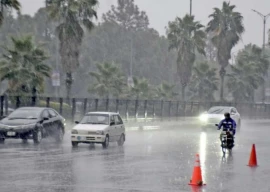
As many as 271 terrorism cases of the 559 that were decided in 2012 by the anti terrorism courts (ATCs) in the Punjab had to be dismissed and the accused acquitted because the witnesses recanted.
Of the 559, convictions were secured in 145 cases, according to official figures.
A total of 414 cases ended in the acquittal of the accused; in 124 of the cases the suspects were acquitted on ‘merits of the case’ and in 19 the parties reached a compromise.
When asked to explain how a compromise could be reached with parties charged or convicted under the said act – since the crimes committed are against the state –, Punjab’s Chief Prosecutor Chaudhry Muhammad Jahangir told The Express Tribune that there were instances in which complainants were private parties and not the state. Such cases are usually registered under Section 302 of the Pakistan Penal Code (murder) along with section 7 of Anti Terrorism Act (ATA). When complainant(s) reach a compromise with the accused, then the respective ATCs let the accused go, taking the view that the main offence was under Section 302 of PPC, which is compoundable, said Jahangir, adding that in most such cases ATCs also declare that sections of the Anti Terrorism Act do not apply.
Khurram Khan, a deputy prosecutor general, attributed the large number of recanting witnesses to “fear, threats and out of court settlements”. Though he was quick to add that charges under the act are non-compoundable, parties do compromise, especially in murder cases. “Since the court does not allow it, witnesses resile,” he told The Express Tribune.
Witnesses have a high rate of recanting because of fear or threats in kidnapping for ransom cases, Khan says. “Very few people come forward. Since we don’t have a witness protection programme, they change their statements,” he says.
When it comes to high profile cases or terrorism attacks, it is usually the police that are the complainants. When they are threatened, says Khan, they give statements contradicting their earlier statements. This results in concessions to or acquittal of the accused.
Nabeela Ghazanfar, the spokesperson for the inspector general of Punjab Police, while talking to The Express Tribune said that there were many flaws in the criminal justice system which caused the acquittals of terror suspects. She said that the majority of acquittals in terrorism cases were due to resiling of witnesses and the inspector general of police as well as the government is considering a witness protection programme to stop that from happening.
Past record:
In August 2011, the US State Department released its 2010 Country Reports on Terrorism in which Pakistan was criticised as being “plagued by an acquittal rate of approximately 75 per cent” and a legal system “almost incapable of prosecuting suspected terrorists”, according to The Telegraph.
Syed Ejaz Hussain, a former DIG with the Counter Terrorism Department, in November 2011 presented a paper Why Do Terrorism Cases Fail in Court? An Empirical Analysis at the American Society of Criminology’s annual meeting in Washington DC.
The paper analysed 178 of judgments between 1990 and 2009. A total of 311 cases were decided in the ATCs. In 231 (74%) cases, trial courts acquitted the suspects. Though Hussain noted that “the courts, [in] almost all cases, used a combination of reasons to acquit the accused,” he identified three main reasons for the high acquittal rate: defects in the registration of cases, defective investigations, and defects at the prosecution stage. The third reason includes witnesses becoming hostile (giving statements that do not help the prosecution case), not appearing for evidence, resiling or changing their statements.
According to the paper, it is “the fear of terrorists among witnesses and the prosecution which led parties to compromise, witnesses to become hostile, or resile in courts or not come for recording evidence at all.” Of the 231, in 86 cases witnesses became hostile, in 48 no witnesses showed up to record evidence, in another 48 the witnesses resiled or compromised with the other party, and in 23 witnesses changed their statements.
What counts as terrorism?
Section 6 of the Anti-Terrorism Act 1997 defines ‘terrorism’ as:
1) In this Act. “terrorism” means the use or threat of action where:
(a) The action falls with the meaning of sub-section (2). And
(b) The use or threat is designed to coerce and intimidate or overawe the Government or the public or a section of the public or community or sect or create a sense of fear or insecurity in society; or
(c) The use or threat is made for the purpose of advancing a religious, sectarian or ethnic cause.
2) An “action” shall fall within the meaning of sub-section(1), if it:
(a) Involves the doing of anything that causes death;
(b) Involves grievous violence against a person or grievous body injury or harm to person;
(c) Involves grievous damage to property:
(d) Involves the doing of anything that is likely to cause death or endangers a person’s life;
(e) Involves kidnapping for ransom, hostage-taking or hijacking;
(f) Incites hatred and contempt on religious, sectarian or ethnic basis to stir up violence or cause internal disturbance;
(g) Involve stoning, brick-batting or any other from of mischief to spread panic:
(h) Involves firing on religious congregations, mosques, imambargahs, churches, temples and all other places of worship, or random firing to spread panic, or involves any forcible takeover of mosques or other places of worship;
(i) Creates a serious risk to safety of public
Or a section of the public, or is designed to frighten the general public and thereby prevent them from coming out and carry8ing on their lawful trade and daily business, and disrupts civil (civic) life;
(j) Involves the burning of vehicles or an other serious form of arson;
(k) Involves extortion of money (bhatta) or property;
(l) Is designed to seriously interfere with or seriously disrupt a communications system or public utility service;
(m) Involves serious coercion or intimidation of a public servant in order to force him to discharge or to refrain from discharging his lawful duties; or
(n) Involves serious violence against a member of the police force, armed forces, civil armed forces, or a public servant.
3) The use or threat or use of any action falling within sub-section (2) which involves the use of fire-arms, explosives or any other weapon, is terrorism, whether or not subsection 1 (c) is satisfied.
4) In this section “action” includes an act or a series of acts.
5) In this Act, terrorism includes any act done for the benefit of a prescribed organization
Published in The Express Tribune, April 1st, 2013.

















COMMENTS
Comments are moderated and generally will be posted if they are on-topic and not abusive.
For more information, please see our Comments FAQ